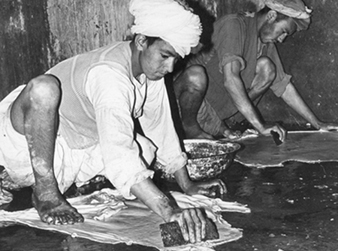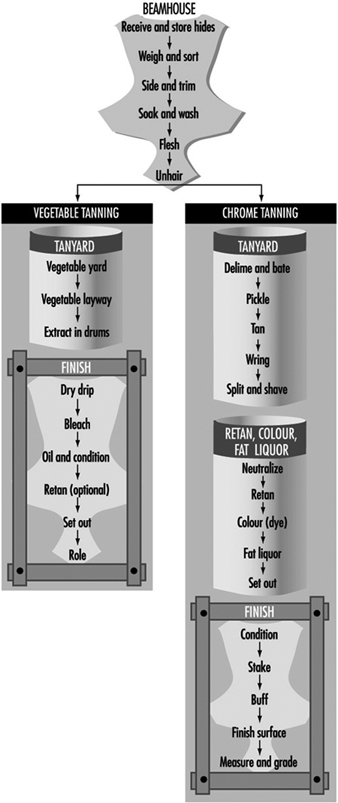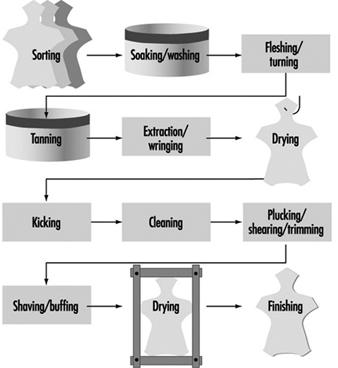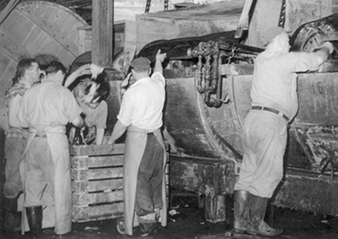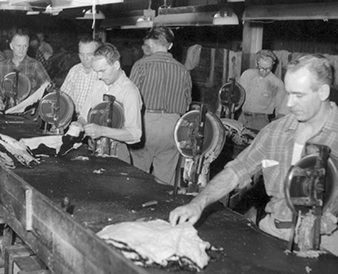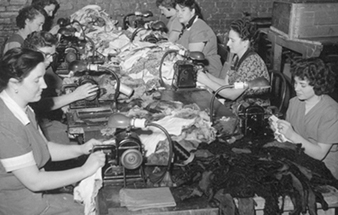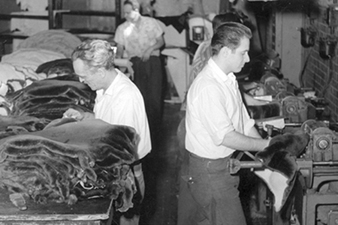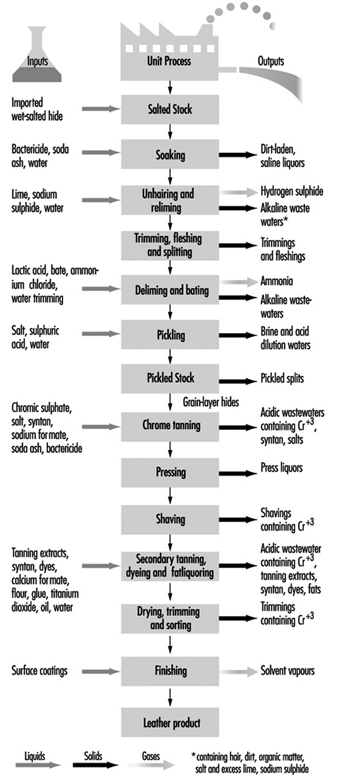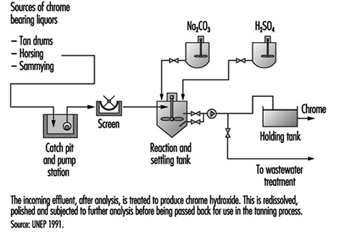
88. Leather, Fur and Footwear
Chapter Editor: Michael McCann
Table of Contents
Tables and Figures
General Profile
Debra Osinsky
Tanning and Leather Finishing
Dean B. Baker
Fur Industry
P.E. Braid
Footwear Industry
F.L. Conradi and Paulo Portich
Health Effects and Disease Patterns
Frank B. Stern
Environmental Protection and Public Health Issues
Jerry Spiegel
Tables
Click a link below to view table in article context.
1. Technological choices for treatment tannery effluents
Figures
Point to a thumbnail to see figure caption, click to see figure in article context.
General Profile
Animal furs and leather from tanned animal hides and skins have been used to make clothing for thousands of years. Fur and leather remain important industries today. Fur is used to produce a variety of outer garments, such as coats, jackets, hats, gloves and boots, and it provides trim for other types of garments as well. Leather is used to make garments and can be employed in the manufacture of other products, including leather upholstery for automobiles and furniture, and a wide variety of leather goods, such as watch straps, purses and suitcases. Footwear is another traditional leather product.
Fur-producing animals include aquatic species such as beaver, otter, muskrat and seal; northern land species such as fox, wolf, mink, weasel, bear, marten and raccoon; and tropical species such as leopard, ocelot and cheetah. In addition, the young of certain animals such as cattle, horse, pig and goat may be processed to produce furs. Although most fur-bearing animals are trapped, mink in particular is produced on fur farms.
Production
The major sources of leather are cattle, pigs, lambs and sheep. As of 1990, the United States was the largest producer of bovine hides and skins. Other significant producers include Argentina, Australia, Brazil, China, France, Germany (former Federal Republic) and India. Australia, China, India, Islamic Republic of Iran, New Zealand, the Russian Federation, Turkey and the United Kingdom are major producers of sheepskins. Goatskins are largely produced in China, India and Pakistan. The major producers of pigskin are China, Eastern Europe and the former USSR.
An analysis prepared by Landell Mills Commodities Studies (LMC) for the International Labour Organization (ILO) shows that the international market for hides is increasingly dominated by a few large producing countries in North America, Western Europe and Oceania, which allow free exportation of hides in any form. The tanning industry in the United States has been shrinking steadily since 1981, while most surviving tanneries in northern Europe have diversified in order to reduce dependence on the footwear-leather market. Worldwide footwear production has continued to shift primarily to Southeast Asia (ILO 1992).
Several factors influence the overall demand for leather throughout the world: the level, rate of growth and distribution of income; the price of leather compared to alternative materials; and changes in consumers’ preference for leather over alternative materials for a variety of products.
The fastest growing end-use sector in the leather industry has been leather upholstery, which accounted for about one-third of the world’s high-quality bovine leather production in 1990. Over one-third of all upholstery leather is destined for the vehicle industry and, according to LMC forecasts, the prospects for this subsector are fairly bright. The proportion of cars with leather upholstery has increased substantially through the 1990s.
The demand for leather garments is determined primarily by income and fashion, while fashion particularly influences the changing demand for specific types of leather. For example, a strong demand for the softer, more supple sheepskin leather in fashion garments motivated the production of the fashionable garment nappa from sheepskins and cattle hides.
The major producers of mink pelts in 1996 were Canada, the Russian Federation, the Scandinavian countries and the United States.
Between 1980 and 1989, leather employment increased in China, Hungary, India, Indonesia, the Republic of Korea, Uruguay and Venezuela and decreased in Australia, Colombia, Kenya, the Philippines, Poland and the United States. Leather employment also fell in Denmark, Finland, Norway and Sweden. In Botswana leather employment declined sharply in 1984, then experienced a steep increase, doubling the 1980 level by 1988.
There are several issues which will affect future production and employment in the leather, footwear and fur industries. New technology, the relocation of footwear production to developing countries and environmental regulations in the tanning industry will continue to affect the skills and the health and safety of workers in these industries.
Tanning and Leather Finishing
Some text was revised from the article authored by V.P.Gupta in the 3rd edition of this Encyclopaedia.
Tanning is the chemical process that converts animal hides and skins into leather. The term hide is used for the skin of large animals (e.g., cows or horses), while skin is used for that of small animals (e.g., sheep). Hides and skins are mostly by-products of slaughterhouses, although they may also come from animals that have died naturally or been hunted or trapped. Tanning industries are usually located near stock-raising regions; however, hides and skins may be preserved and transported prior to tanning, so the industry is widespread.
The tanning process consists in strengthening the hide’s protein structure by creating a bond between the peptide chains. The hide is composed of three layers: epidermis, dermis and subcutaneous layer. The dermis consists of about 30 to 35% protein, which is mostly collagen, with the remainder being water and fat. The dermis is used to make leather after the other layers have been removed using chemical and mechanical means. The tanning process uses acids, alkalis, salts, enzymes and tanning agents to dissolve fats and non-fibrous proteins and chemically bond the collagen fibres together.
Tanning has been practised since prehistoric times. The oldest system of tanning relies on the chemical action of vegetable material containing tannin (tannic acid). Extracts are taken from the parts of plants that are rich in tannin and processed into tanning liquors. The hides are soaked in pits or vats of increasingly strong liquors until they are tanned, which may take weeks or months. This process is used in countries with low levels of technology. This process is also used in developed countries to produce firmer, thicker leather for shoe soles, bags, cases and straps, although process changes have been introduced to shorten the time needed for tanning. Chemical tanning using mineral salts such as chromium sulphate was introduced during the late 19th century and has become the primary process to produce softer, thinner leather for goods such as handbags, gloves, garments, upholstery and shoe uppers. Tanning may also be accomplished using fish oils or synthetic tannins.
There is great variation in the scale and types of tanning facilities. Some tanneries are highly mechanized and use closed automatic systems and many chemicals, whereas others still use largely manual work and natural tanning substances with techniques essentially unchanged over the centuries (see figure 1). The type of product required (e.g., heavy-duty leather or fine flexible leathers) influences the choice of tanning agents and the finishing required.
Figure 1. Manual working methods in an Afghanistan tannery
Process Description
Leather production can be divided into three stages: preparation of the hide for tanning, which includes processes such as the removal of hair and adherent flesh; the tanning process; and the finishing process. Finishing includes mechanical processes to shape and smooth the leather and chemical treatments to colour, lubricate, soften and apply a surface finish to the leather (see figure 2). All of these processes may take place in one facility, although it is common for leather finishing to be conducted at locations different from tanning in order to take advantage of transportation costs and local markets. The implication is that it affects the likelihood of cross-contamination among the processes.
Figure 2. Typical processes for leather tanning & finishing
Curing and shipment. Because raw hides and skins decay rapidly, they are preserved and disinfected prior to shipment to the tannery. The hide or skin is flayed from the carcass and then preserved by curing. Curing can be accomplished by a variety of means. Curing by drying is suitable in regions where hot and dry climatic conditions prevail. Drying consists of stretching the hides on frames or spreading them on the ground in the sun. Dry-salting, another method of curing hides, consists of rubbing the fleshy side of the hide with salt. Brine curing, or brining, consists of submerging the hides in a solution of sodium chloride to which naphthalene may have been added. Brining is the most common form of preservation in developed countries.
Prior to shipment, hides are generally treated with DDT, zinc chloride, mercury chloride, chlorophenols or other agents for disinfection. These substances may represent hazards both at the site of curing and on receipt at the tannery.
Preparation. The cured hides and skins are prepared for tanning by several operations, collectively referred to as beamhouse operations. First the hides are sorted, trimmed and then washed in vats or drums. Disinfectants such as bleaching powder, chlorine and sodium acid fluoride in the water prevent putrefaction of hides. Chemicals such as caustic soda, sodium sulphide and surfactants are added to the water to accelerate soaking of dry-salted or dried hides.
The soaked hides and skins are then limed by immersing in milk of lime to loosen the epidermis and hair roots and to remove other unwanted soluble proteins and fats. In another method, a depilatory paste of lime, sulphide and salt is applied to the flesh side of the skins in order to save hair and wool. The limed hides are unhaired to remove the loosened hairs and defleshed. Epidermal debris and fine hair roots are mechanically removed by the scudding operation.
These operations are followed by deliming and bating with buffering salts, such as ammonium sulphate or ammonium chloride, and the action of proteolytic enzymes neutralizes the high alkalinity of limed hides. In pickling, hides are placed in an acid environment consisting of sodium chloride and sulphuric acid. The acid is necessary because chrome-tanning agents are not soluble under alkaline conditions. Vegetable-tanned hides do not need to be pickled.
Many of the beamhouse operations are carried out by processing the hides in solutions using large pits, vats or drums. Solutions are piped or poured into the containers and later emptied through pipes or into open drainage channels in the work area. The chemicals may be added to the containers by pipes or manually by workers. Good ventilation and personal protective equipment are needed to prevent respiratory and dermal exposure.
Tanyard. Various substances may be used for tanning, but the main distinction is between vegetable and chrome tanning. Vegetable tanning may be carried out either in pits or in rotating drums. Rapid tanning, in which high concentrations of tannins are used, is carried out in rotating drums. The chrome-tanning process most often used is the one-bath method, in which the hides are milled in a colloidal solution of chromium (III) sulphate until tanning is complete. A two-bath chrome-tanning process was used in the past, but this process involved potential exposure to hexavalent chromium salts and required more manual handling of the hides. The two-bath process is now considered obsolete and is rarely used.
Once tanned, the hide is further processed to shape and condition the leather. The hide is removed from the solution and excess water is removed by wringing. Chrome leather must be neutralized after being tanned. Splitting is the longitudinal division of wet or dry leather that is too thick, for articles such as shoe uppers and leather goods. Roll machines with cutting blades are used to further reduce the leather to the thickness required. A large amount of dust may be released when the leather is split or shaved while dry.
Re-tanning, colouring and fat-liquoring. After tanning, most leathers except sole leathers undergo colouring (dyeing). Generally, colouring is performed in a batch mode; and re-tanning, colouring and fat liquoring operations are all performed in sequence in the same drum with intermediate steps of washing and drying. Three major types of dyes are used: acid, basic and direct. Blends of dyes are used in order to obtain the exact shade desired, so the composition is not always known except by the supplier. The purpose of fat-liquoring is to lubricate leather to give it strength and flexibility. Oils, natural fats, their transformation products, mineral oils and several synthetic fats are used.
Finishing. After drying, vegetable tanned leather is subjected to mechanical operations (setting and rolling) and given a final polish. The finishing process for chrome leather includes a series of mechanical operations and, normally, the application of a covering layer to the leather surface. Staking is a mechanical beating operation used to make the leather soft. To improve the final appearance, the grain side of the leather is buffed using a sanding drum. This process generates a tremendous amount of dust.
A final surface finish is applied, which may contain solvents, plasticizers, binders and pigments. These solutions are applied by pads, flow coating or spraying. Some tanneries employ hand labour to apply the finish using pads, but this is usually carried out by machines. In flow coating, the solution is pumped into a reservoir above the conveyor carrying the leather and flows down onto it. In most cases, painted or sprayed leathers are not dried in ovens, but on trays on shelves. This practice provides a wide evaporating surface and contributes to air pollution.
Hazards and Their Prevention
Infectious hazards. In the early stages of the beamhouse operations, there may be some risk of infection due to zoonoses from the raw hides. Anthrax was a recognized hazard among workers engaged in handling hides and skins, particularly dry and dry-salted hides. This hazard has been virtually eliminated in tanneries due to disinfection of hides prior to shipment to the facilities. Colonies of fungi may develop on leathers and on the surface of the liquors.
Injuries. Slippery, wet and greasy floors form a serious hazard in all parts of a tannery. All floors should be of impervious material, have an even surface and be well drained. Good maintenance and housekeeping are essential. Mechanized transfer of hides and skins from one operation to another and proper drainage of liquors from vats and drums will help to reduce spillage and manual-handling ergonomic problems. Open pits and vats should be fenced to prevent injuries due to drowning and scalds.
There are many hazards connected with the operating parts of the machines—for example, injuries caused by revolving drums, in-running rollers and knives. Efficient guarding should be provided. All transmission machinery, belts, pulleys and gear wheels should be guarded.
Several operations involve manual lifting of the hides and leather, which represents an ergonomic hazard. Noise associated with the machinery is another potential hazard.
Dust. Dust is produced in a variety of tanning operations. Chemical dust can be produced during the loading of hide-processing drums. Leather dust is produced during mechanical operations. Buffing is the major source of dust. The dust in tanneries may be impregnated with chemicals, as well as fragments of hair, mould and excrement. Effective ventilation is needed for dust removal.
Chemical hazards. The large variety of acids, alkalis, tannins, solvents, disinfectants and other chemicals can be respiratory and skin irritants. Dusts of vegetable tanning materials, lime and leather and chemical mists and vapours arising in the various processes may be responsible for causing chronic bronchitis. Several chemicals may cause contact dermatitis. Chrome ulceration may occur in chrome tanning, especially on the hands. Exposures in the beamhouse operations are mainly to sulphur compounds such as sulphides and sulphates. Since these are alkaline substances, there is a potential to generate hydrogen sulphide gas if these substances contact acids.
Potential cancer-causing agents used in leather tanning and finishing include hexavalent chromium salts (in the past), aniline and azo dyes, vegetable tannins, organic solvents, formaldehyde and chlorophenols. The International Agency for Research on Cancer (IARC) evaluated the leather tanning industry in the early 1980s and concluded that there was no evidence to suggest an association between leather tanning and nasal cancer (IARC 1981). Case reports and epidemiological studies since the IARC evaluation have indicated increased risk for cancers among leather tanning and finishing workers—including lung cancer, sinonasal cancer and pancreatic cancer associated with leather dust and tanning (Mikoczy et al. 1996) and bladder cancer and testicular cancer associated with dyes or solvents in the finishing process (Stern et al. 1987). None of these associations is clearly established at this time.
Fur Industry
Adapted from the article by the author that appeared in the 3rd edition of this Encyclopaedia. Acknowledgements to Gary Meisel and to Tom Cunningham of the United Food and Commercial Workers Union for reviewing and adapting this article
Rudimentary means of preserving furs have been used since very early times and are still practised in many parts of the world. Typically, after the pelt is scraped and cleaned by washing, the skin is impregnated with animal oil, which serves to preserve it and make it more pliable. The pelt may be beaten or chewed after the oil treatment in order to effect better impregnation by the oil.
In the modern fur industry, pelts are obtained from fur farmers, trappers or hunters. At this stage they have been stripped from the carcass, flesh and fatty deposits have been removed by scraping and the pelts have been stretched and air dried. The fur industry grades the pelts according to factors such as the general condition of the pelt, fur length, curl and patterning. The pelts go through a series of treatment steps, called fur dressing, to preserve them (see figure 1). The furs may also be dyed. Fur dressing and dyeing are done in batches, with the pelts usually being transferred from one step to another using hand carts.
Figure 1. Flow chart of fur dressing
Fur Dressing
First, the pelts are sorted, stamped with an identifying mark, and cut open using knives and snippers. They are then soaked in salt water in tubs or barrels for several hours to re-soften them (see figure 2). Rotating paddles are often used to help this soaking. Sometimes formic acid, lactic acid or sulphuric acid is used in the soaking step. The excess water is then removed in revolving drums.
Figure 2. Soaking department in a fur-processing works
Office du film du Quebec
Next, the underside of the pelt is drawn across razor-sharp round-knife fleshing machines by workers known as fleshers (figure 3). Hand turning (turning the pelt inside out) and trimming with knives is also done. This operation removes the loose connective tissue from the underside of the skin. The object is to remove, as far as possible, any tissue which is not involved in the attachment of the fur, thus producing the maximum degree of lightness and flexibility of the pelt.
Figure 3. Machine fleshing of lamb skins
Office du film du Quebec
The pelts are now ready for tanning and are soaked in alum solution in pits or tubs. As with soaking, paddles are used. The alum solution is usually acidified somewhat with hydrochloric or sulphuric acid. The alum treatment may be carried out in either an aqueous or an oil solution. Excess liquid is extracted and the pelts are dried in special drying rooms to set the skin collagen.
The tanned pelts are then treated with an oil solution in a kicking machine or similar type of machine to force the oil into the skin. They are then cleaned in rotating drums containing sawdust, which absorbs moisture and excess oil.
Pelts contain guard hairs as well as the softer fur fibres. The guard hairs are stiffer and longer than the fur fibres and, depending on the type of fur and the final product desired, these hairs may be either partially or totally removed by machine or by hand plucking. Some pelts also require shearing or trimming with knives (see figure 4).
Figure 4. Shearing operation on Canadian beaver pelts
Office du film du Quebec
Other steps can include shaving or “paring out” with round-knife fleshers, buffing with buffing machines, drying and finishing. The latter can include degreasing, stretching, cleaning, buffing, brushing and lusterizing with lacquers and resins.
Dyeing
Although dyeing of furs was at one time not looked upon favourably, it is now an accepted part of fur preparation and is practised extensively. This can be done at the same time as tanning or in a subsequent step. The usual procedure involves treatment of the pelts with a weak alkaline solution (e.g., sodium carbonate) to remove dirt and oil residues. The pelts are then soaked in a mordant solution (e.g., ferric sulphate), after which they are steeped in dye solution until the desired colour is obtained. They are then repeatedly rinsed and drum-dried with the aid of sawdust.
Many other chemicals may be used in dyeing, including ammonia, ammonium chloride, formaldehyde, hydrogen peroxide, lead acetate or nitrate, oxalic acid, sodium perborate,
p-phenylenediamine dyes, benzidine dyes and so forth.
Fur Garment Manufacture
Before being made into garments, pelts may be cut and “let out”. This involves making a series of closely spaced diagonal or V-shaped slits in the skin, after which the pelt is pulled in order either to lengthen or to broaden it as needed. The pelt is then re-sewn (see figure 5). This type of operation requires great skill and experience. The pelts are next thoroughly moistened and then laid out and tacked on a board according to a chalked-on pattern, left to dry and sewn together. Finally, lining and other finishing steps complete the garment.
Figure 5. Operators engaged in the machine sewing of skins
Office du film du Quebec
Hazards and Their Prevention
Accidents
Some of the machines used in fur processing present serious hazards unless sufficient guarding is maintained: in particular, all drums should be protected with an interlocking gate and the centrifuges used for extraction of moisture should be fitted with interlocking lids; fur clipping and fur cutting machines should be totally enclosed except for the feed and discharge openings.
Vats should be covered or effectively railed to prevent accidental immersion. Falls on wet and slippery floors can be largely prevented by maintenance of sound, impervious surfaces, well-drained and frequently cleaned. Dyeing vats should be surrounded by drainage channels. Accidents caused by hand tools can be reduced if the handles are well designed and the tools well maintained. In the fur manufacturing sector, sewing machines require similar protection to those used in the garment trade (e.g., guarding of driving mechanisms and of needles).
Health Hazards
The use by the fur industry of such a large proportion of pelts from animals bred in captivity has considerably reduced the likelihood of transmission of animal diseases to fur workers. Nevertheless, anthrax may occur in workers handling carcasses, skins, hides or hairs from infected animals; a vaccine may be administered to all likely to have contact. All concerned should be aware of the risk and trained to report any suspicious symptoms immediately.
Various chemicals used in the fur industry are potential skin irritants. These include alkalis, acids, alum, chromates, bleaching agents, oils, salt and the compounds involved in the dyeing process, which comprise various types of dyes as well as mordants.
Unpacking of bales which have been treated with dusting powder in their countries of origin, drumming, plucking, unhairing and shearing can all produce irritant dust. In dye houses and dye kitchens, where salts of lead, copper and chromium (and possibly carcinogenic dyes) are weighed and cooked, there is also a risk of ingestion of toxic dusts. Injurious vapours may arise from degreasing solvents and fumigating chemicals. There is also the possibility of development of contact sensitization (allergy) to some of these chemicals or to the dust from one or more of the types of fur being handled.
The main protection against the hazards of dust and vapours is the provision of local exhaust ventilation; good general ventilation is also necessary throughout the process. Good housekeeping is important to remove dust. Personal respiratory protective equipment may be necessary for short-term jobs or in addition to local exhaust at particularly dusty operations. Particular attention should be paid to potential confined space hazards in pits and vats used for soaking/washing, tanning and dyeing.
Protective clothing appropriate to the process is necessary at most stages of fur processing. Rubber hand protection, foot and leg protection and aprons are required for wet processes (e.g., at the dye and mordant vats) and as a protection against acids, alkalis and corrosive chemicals. Good sanitary and washing facilities, including showers, should be provided. Bleaches and strong alkali soaps should not be used for hand cleansing.
Ergonomic problems can result from manual lifting and moving of materials, especially pushing hand carts, and manual loading and unloading of pelts (particularly when wet). Automation of these processes can help solve these problems. Repetitive motions in fur garment manufacture are also a source of ergonomic problems.
Heat stress diseases can occur while working in the drying room. Preventive measures include adequate exhaust of hot air and supply of cool air, limiting exposure time, readily accessible drinking water and training in the recognition of heat stress symptoms and in first aid measures.
Noise can be a problem with many of the machines used, especially in drums and combing, shearing and lusterizing machines.
Pre-placement medical examination can assist in the prevention of dermatitis by proper placement of employees with a history of sensitivity. Medical supervision is desirable; well maintained first-aid provisions in the charge of trained personnel are essential. Strict attention to hygiene, ventilation and temperature are necessary in the many small workrooms in which much of the making of fur garments is done.
Footwear Industry
Adapted by P. Portich from the article in the 3rd edition of this Encyclopaedia by F.L. Conradi.
The term footwear covers a vast range of products made from many different materials. Boots, shoes, sandals, slippers, clogs and so forth are made wholly or partly of leather, rubber, synthetic and plastics materials, canvas, rope and wood. This article deals with the footwear industry as generally understood (i.e., based on traditional manufacturing methods). The manufacture of rubber boots (or their synthetic equivalents) is essentially a section of the rubber industry, which is covered in the chapter Rubber industry.
Shoes, boots and sandals made from leather, felts and other materials have been made by hand over the centuries. Fine shoes are still made wholly or partly by hand, but in all the industrialized countries there are now large mass-production plants. Even so, some work may still be given out to be done as home work. Child labour continues as one of the more serious problems in the footwear industry, although several countries have taken action against child labour with the help of various international programmes in this area.
Boot and shoe plants usually locate close to leather-producing areas (i.e., near cattle-raising country); some slipper and light-shoe making developed where there was a plentiful supply of felts from the textile trade, and in most countries the industry tends to be localized in its original centres. Leathers of different type and quality, and some reptile skins, formed the original materials, with a tougher quality skin for the soles. In recent years leather has been increasingly displaced by other materials, in particular rubber and plastics. Linings may be made of wool or polyamide (nylon) fabric or sheepskin; laces are made of horsehair or synthetic fibres; paper, cardboard and thermoplastics are used for stiffening. Natural and coloured wax, aniline dyes and colouring agents are used in finishing.
Economic and other factors have transformed the footwear industry in recent years. Tennis shoe manufacturing is one of the major growth sectors of the industry and has moved from production in predominantly one country to worldwide production, especially in developing countries in Asia and South America, in order to increase production and reduce costs. This migration of production to developing countries has also occurred in other sectors of the footwear industry.
Processes
There may be over a hundred operations in the making of a shoe, and only a brief summary is possible here. Mechanization has been applied at all stages, but the pattern of the hand process has been closely followed. Introduction of new materials has modified the process without changing its broad outline.
In the making of the uppers (tops of shoes), the leather or other material is sorted and prepared, and the uppers are then cut out on stitching (or dinting) presses by shaped, loose-knife tools. The parts, including the linings, are then “closed” (i.e., sewn or stuck together). Perforating, eyeletting and button-holing may also be carried out.
For making the bottom stock, soles, insoles, heels and welts, pieces are cut out in revolving presses using loose-knife cutters, or in sole-moulding presses; heels are made by compression of leather or wood strips. The stock is trimmed, shaped, scoured and stamped.
The uppers and bottom stock are assembled and then stitched, glued, nailed or screwed together. These operations are followed by shaping and levelling between rollers. The final finishing of the shoe includes waxing, colouring, spraying, polishing and packaging.
Among the raw materials used in the manufacturing process, the most important from the point of view of occupational hazards are the adhesives. These include natural solid and liquid adhesives and adhesive solutions based on organic solvents.
Hazards and Their Prevention
The intensive use of flammable liquids constitutes a considerable fire hazard, and the widespread use of presses and assembling machines has introduced an increased risk of mechanical accidents into this industry. The main health hazards are toxic solvents, high atmospheric dust concentrations, ergonomic risks and noise from the machines.
Fire
The solvents and sprays used in adhesives and finishing materials may be highly flammable. Precautions include:
- using the lowest flash point solvents possible
- using good general ventilation and local exhaust ventilation in spray booths and drying racks to reduce the concentration of flammable vapours
- removing combustible residues from cabinets and workbenches and provide closed containers for solvent-containing and oily wastes
- maintaining unobstructed exits and gangways
- minimizing the amount of stored flammable liquids; keep them in approved containers, cabinets and storage rooms
- ensuring that all electrical equipment and wiring near flammable solvents meets appropriate electrical codes
- grounding adequately polishing machines and other sources of static electricity.
Accidents
Many of the operating parts of the machines present serious hazards, in particular presses, stampers, rollers and knives. The loose-knife cutters at stitching and revolving presses can cause serious injury. The appropriate precautions minimally include two-hand controls (a photo-electric cell device for automatically cutting power may be preferable), the reduction of stroke rate to a safe level in relation to the size of the cutter, and the use of well-designed, stable cutters of adequate height, with flanges fitted perhaps with handles. Sole-moulding and heel presses should be guarded to prevent hand access. Stamping machines can cause burns as well as crushing injuries unless hand access is prevented by guarding. Nips of rollers and knives of milling and shaping machines should be fitted with suitable machinery guarding. The shading and polishing wheels of finishing machines and the spindles on which they are mounted should also be guarded. There should be an effective lockout/tagout programme for repair and maintenance work.
Health hazards
Organic solvents can cause acute and chronic effects on the central nervous system. Benzene, which was formerly used in adhesives and solvents, has been replaced by toluene, xylene, hexane, methyl ethyl ketone (MEK) and methyl butyl ketone (MBK). Both n-hexane and MBK can cause peripheral neuropathy and should be replaced by heptane or other solvents.
Outbreaks of a disease known popularly as “shoemakers’ paralysis” have appeared in a number of factories, presenting a clinical picture of a more or less severe form of paralysis. This paralysis is of the flaccid type, it is localized in the limbs (pelvic or thoracic) and gives rise to osteo-tendinous atrophy with areflexia and no alteration in superficial or deep sensitivity. Clinically, it is a syndrome resulting from functional inhibition or injury of the lower motor neurons of the voluntary motor system (pyramidal tract). The common outcome is neurological regression with extensive proximo-distal functional recuperation.
Good general ventilation and exhaust ventilation at the point of origin of the vapours should be provided to maintain concentrations well below maximum permissible levels. If these levels are observed, the fire risk will also be diminished. Minimizing the amount of solvent used, enclosure of solvent-using equipment and closing solvent containers are also important precautions.
Finishing machines produce dust, which should be removed from the atmosphere by exhaust ventilation. Some of the polishes, stains, colours and polychloroprene glues may carry a dermatitis risk. Good washing and sanitary facilities should be maintained and personal hygiene encouraged.
The increased intensive use of machines and equipment creates a significant noise hazard, necessitating source control of the noise or other preventive measures to prevent hearing loss. There should also be a hearing conservation programme.
Prolonged work on nailing machines which produce high levels of vibration may produce “dead hand” (Raynaud’s phenomenon). It is advisable to restrict the time spent at these machines.
Low-back pain and repetitive strain injuries are two musculoskeletal diseases that are major problems in the footwear industry. Ergonomic solutions are essential for prevention of these problems. Pre-placement and periodic medical examinations linked to workplace hazards are an effective factor for protection of employees’ health.
Environmental and Public Health Hazards
Earth Summit 1992, held in Rio de Janeiro, dealt with environmental concerns, and its proposals for future action, known as Agenda 21, could transform the footwear industry with its emphasis on recycling. In general, however, most waste materials are disposed of in landfills. Without proper precautions, this can result in contamination of the ground and groundwater.
Although home work has social advantages in decreasing unemployment and in the formation of cooperatives, the problems of ensuring proper precautions and working conditions in the home are enormous. In addition, other family members can be at risk if they are not already involved in the work. As discussed previously, child labour remains a serious problem.
Health Effects and Disease Patterns
Leather Tanning
The major International Standard Industrial Classification (ISIC) group for the leather and fur processing is 323. In the United States, the Standard Industrial Classification (SIC) group for leather and leather manufacturing products industry is SIC 311 (OMB 1987). This group includes establishments engaged in tanning, currying and finishing hides and skins, as well as establishments manufacturing finished leather and artificial leather products and some similar products made of other materials. Leather converter, belting and chamois leather are also included in SIC 311. In addition, parts of SIC 23 (i.e., SIC 2371 and 2386) include establishments involved in the manufacturing of coats, garments, accessories and trimmings made of fur and establishments involved in sheep-lined clothing.
There are many varieties of leather with different characteristics depending upon the animal species and the specific part of the body of the animal from which the hide is obtained. Hides are made from cattle or horse skins; fancy leather from the skin of the calf, pig, goat, sheep and so on; and reptile leather from crocodile, lizard, chameleon and so on.
Employment in the leather and leather manufacturing products industry has been associated with various diseases caused by biological, toxicological and carcinogenic agents. The specific disease associated with exposure in the leather industry depends upon the extent to which the worker is exposed to the agent(s), which is dependent upon the occupation and work area within the industry.
For the tanning process, the epidermis of the hide is first removed and only the dermis transformed into leather. During this process, infection is a constant hazard, since the hide serves as a medium for numerous micro-organisms. Colonies of fungi may develop, specifically Aspergillus niger and Penicillus glaucum (Martignone 1964). To avoid the development of fungi, chlorinated phenols, specifically pentachlorophenol, have been widely used; unfortunately, such chemicals have been found to be toxic to the worker. Yeasts of three genera (Rhodotorula, Cladosporium and Torulopsis) have also been found (Kallenberger 1978). Tetanus, anthrax, leptospirosis, epizootic aphtha, Q fever and brucellosis are examples of diseases that workers could contract during the tanning process due to infected hides (Valsecchi and Fiorio 1978).
Skin disorders such as eczema and contact (allergic) dermatitis have also been diagnosed among leather tanners exposed to preservatives applied to the hides (Abrams and Warr 1951). The leather tanning and finishing process has been shown to have the highest incidence of dermatoses of any working group in the United States (Stevens 1979). Irritations of the mucous membranes of the throat and nose and perforations of the nasal septum may also occur after inhaling chromic acid fumes liberated during the chrome-tanning process.
Tannery workers have the potential for exposure to numerous known or suspected occupational carcinogens, including hexavalent chromium salts, benzidine-based azo dyes, organic solvents (e.g., benzene and formaldehyde), pentachlorophenol, N-nitroso compounds, arsenic, dimethylformamide and airborne leather dusts. These exposures may result in the development of various site-specific cancers. An excess of lung cancer has been observed in studies carried out in Italy (Seniori, Merler and Saracci 1990; Bonassi et al. 1990) and in a case-control study carried out in the United States (Garabrant and Wegman 1984), but this result is not always supported by other studies (Mikoczy, Schutz and Hagmar 1994; Stern et al. 1987; Pippard and Acheson 1985). Chromium and arsenicals were mentioned as possible contributors to the lung cancer excess. A significantly increased risk of soft tissue sarcoma has been observed in at least two separate tannery studies, one in Italy and one in the United Kingdom; the investigators of both studies suggest that the chlorophenols used at the tanneries may have produced these malignancies (Seniori et al. 1989; Mikoczy, Schutz and Hagmar 1994).
A threefold statistically significant excess in pancreatic cancer mortality was noted in a Swedish case control study (Erdling et al. 1986); a 50% increase in pancreatic cancer was also noted in another study examining three Swedish tanneries (Mikoczy, Schutz and Hagmar 1994) and in a study of an Italian tannery (Seniori et al. 1989). Despite the excess risk of pancreatic cancer, no specific environmental agent was identified, and dietary factors were considered a possibility. An excess risk of testicular cancer was observed among leather tanners from the finishing department of one tannery; all three workers with testicular cancer had worked during the same time period and were exposed to dimethylformamide (Levin et al. 1987; Calvert et al. 1990). An excess risk of sinonasal cancer among leather tannery workers was observed in a case-control study in Italy; chromium, leather dust and tannins were indicated as possible aetiological agents (Comba et al. 1992; Battista et al. 1995). However, IARC research in the early 1980s found no evidence of an association between leather tanning and nasal cancer (IARC 1981). The results of a study of the Chinese leather tanning industry showed a statistically significant excess morbidity from bladder cancer among those tanners ever exposed to benzidine-based dyes, which increased with duration of exposure (Chen 1990).
Accidents are also a leading cause of disability in leather tannery workers. Slips and falls on wet and greasy floors are common, as are knife cuts from the trimming of hides. In addition, the machines used to process the hides are capable of crushing and inflicting bruises, abrasions and amputations. For example, United States Bureau of Labor Statistics (BLS) data for 1994 have shown an incidence rate in SIC 311 for injuries and illnesses combined of 19.1 per 100 full-time workers and an incidence rate for injuries alone of 16.4. These results are over 50% higher than the all-manufacturing incidence for illnesses and injuries combined, 12.2 per 100 full-time workers, and the incidence of 10.4 for injuries alone (BLS 1995).
Footwear
The handling and processing of leather in the manufacturing of shoes and boots may entail exposures to some of the same chemicals used in the tanning and finishing processes as cited above, giving rise to similar diseases. Furthermore, different chemicals used may also produce other diseases. Exposures to the toxic solvents used in adhesives and cleaners and to airborne leather dusts are of particular concern. One solvent of specific concern is benzene, which can produce thrombocytopenia; depression of the red blood cell, platelet and white cell counts; and pancytopenia. Benzene has largely been eliminated from the footwear industry. Peripheral neuropathy has also been found among workers in shoemaking factories due to n-hexane in the adhesives. This, too, has largely been substituted for by less toxic solvents. Electroencephalographic changes, liver damage and behavioural alterations have also been reported in connection with exposure to solvents in shoeworkers.
Benzene has been judged to be a human carcinogen (IARC 1982), and various investigators have observed excess leukaemias among workers exposed to benzene in the shoe industry. One study included the largest shoe manufacturing facility in Florence, Italy, consisting of over 2,000 employees. The study results revealed a fourfold excess risk of leukaemia, and benzene was cited as the most likely exposure (Paci et al. 1989). A follow-up to this study showed an over fivefold risk for those shoe workers employed in jobs where benzene exposure was substantial (Fu et al. 1996). A study in the United Kingdom examining mortality among males employed in shoe manufacturing found an elevated risk for leukaemia among workers handling glues and solvents which contained benzene (Pippard and Acheson 1985). Various studies of shoe industry workers in Istanbul, Turkey, have reported an excess risk of leukaemia from exposure to benzene. When benzene was later replaced by petrol, the absolute number of cases and risk of leukaemia dropped considerably (Aksoy, Erdem and DinCol 1974; 1976; Aksoy and Erdem 1978).
Various types of nasal cancer (adenocarcinoma, squamous-cell carcinoma and transitional-cell carcinoma) have been associated with employment in shoe manufacture and repair. Relative risks in excess of tenfold have been reported from studies in Italy and the United Kingdom (Fu et al. 1996; Comba et al. 1992; Merler et al. 1986; Pippard and Acheson 1985; Acheson 1972, 1976; Cecchi et al. 1980) but not in the United States (DeCoufle and Walrath 1987; Walker et al. 1993). The elevated nasal cancer risks were almost entirely accounted for by employees “heavily” exposed to leather dust in the preparation and finishing rooms. The mechanism by which exposure to leather dust may increase the risk of nasal cancer is not known.
Excesses of digestive and urinary tract cancers, such as bladder (Malker et al. 1984; Morrison et al. 1985), kidney (Walker et al. 1993; Malker et al. 1984), stomach (Walrath, DeCoufle and Thomas 1987) and rectal (DeCoufle and Walrath 1983; Walrath, DeCoufle and Thomas 1987) cancers, have been found in other studies of shoe workers but have not been consistently reported and have not been linked with particular exposures in the industry.
Ergonomic hazards causing work-related musculoskeletal disorders (WRMDs) are major problems in the shoe manufacturing industry. These hazards are due to the specialized equipment used and hands-on work requiring repetitive movements, forceful exertions and awkward body postures. BLS data show men’s footwear to be one of the “industries with the highest rates of nonfatal illness disorders associated with repeated trauma” (BLS 1995). The incidence rate for the total footwear industry for illnesses and injuries combined was found to be 11.9 per 100 workers, with 8.6 being the incidence rate for injuries alone. These rates are slightly less than the incidence rates for all manufacturing. WRMDs in the shoe manufacturing industry include conditions such as tendinitis, synovitis, tenosynovitis, bursitis, ganglionic cysts, strains, carpal tunnel syndrome, low-back pain and cervical spine injuries.
Fur Workers
Fur processing involves the activities of three categories of workers. Fur dressers flesh and tan skins; fur dyers then colour or tint the skins with natural or synthetic dyes; and finally fur service workers grade, match and bale dressed furs. Dressers and dyers are exposed to potential carcinogens including tannins, oxidative dyes, chromium and formaldehyde, whereas fur service workers are potentially exposed to residual tanning materials while handling previous dressed furs. Very few epidemiological studies have been conducted on fur workers. The only comprehensive study among these workers revealed statistically elevated risks of colo-rectal and liver cancer among the dyers, lung cancer among the dressers and cardiovascular diseases among the service workers as compared to overall rates in the United States (Sweeney, Walrath and Waxweiler 1985).
Environmental Protection and Public Health Issues
The treatment and processing of animal skins and hides can be a source of considerable environmental impact. Discharged wastewater contains pollutants from the hides, products from their decomposition and chemicals and various spent solutions used for hide preparation and during the tanning process. Solid wastes and some atmospheric emissions also may arise.
The major public concern over tanneries has traditionally been about odours and water pollution from untreated discharges. Other issues have arisen more recently from the increasing use of synthetic chemicals such as pesticides, solvents, dyes, finishing agents and new processing chemicals which introduce problems of toxicity and persistence.
Simple measures intended to control pollution can themselves create secondary cross-media environmental impacts such as groundwater pollution, soil contamination, sludge dumping and chemical poisoning.
Tanning technology that is now available, based on a lower chemical and water consumption, has less impact on the environment than traditional processes. However, many obstacles remain to its widespread application.
Figure 1 presents the different wastes and environmental impacts associated with the various processes used in the tanning industry.
Figure 1. Environmental impacts & tannery operations
Pollution Control
Water pollution control
Untreated tannery wastes in surface waters can bring about a rapid deterioration of their physical, chemical and biological properties. Simple end-of-pipe effluent treatment processes can remove over 50% of suspended solids and biochemical oxygen demand (BOD) of effluent. More sophisticated measures are capable of higher levels of treatment.
As tannery effluents contain several chemical constituents that need to be treated, a sequence of treatment processes in turn must be used. Flow segregation is useful to allow separate treatment of concentrated waste streams.
Table 1 summarizes technological choices available for treatment of tannery effluents.
Table 1. Technological choices for treatment of tannery effluents
|
Pre-treatment settling |
Mechanical screening to remove coarse material Flow equalization (balancing) |
|
Primary treatment |
Sulphide removal from beamhouse effluents Chromium removal from tanning effluents Physical-chemical treatment for BOD removal and neutralization |
|
Secondary treatment |
Biological treatment Activated sludge (oxidation ditch) Activated sludge (conventional) Lagooning (aerated, facultative or anaerobic) |
|
Tertiary treatment |
Nitrification and denitrification |
|
Sedimentation and sludge handling |
Different shapes and dimensions of tanks and basins |
Air pollution control
Air emissions fall into three broad groups: odours, solvent vapours from finishing operations and gas emissions from the incineration of wastes.
Biological decomposition of organic matter as well as sulphide and ammonia emissions from wastewaters are responsible for the characteristic objectionable odours arising from tanneries. The siting of installations has been an issue because of the odours that have historically been associated with tanneries. Reduction of these odours is more a question of operational maintenance than of technology.
Solvent and other vapours from the finishing operations vary with the type of chemicals used and the technical methods employed to reduce their generation and release. Up to 30% of the solvent used may be wasted through emissions, while modern processes are available to reduce this to around 3% in many cases.
The practice by many tanneries of incinerating solid wastes and offcuts raises the importance of adopting good incinerator design and following careful operating practices.
Waste management
Treatment of sludge constitutes the largest disposal problem, apart from effluent. Sludges of organic composition, if free from chrome or sulphides, have value as a soil conditioner as well as a small fertilizer effect from nitrogenous compounds contained therein. These benefits are best realized by ploughing immediately after application. Agricultural use of chrome-containing soils has been a matter of controversy in various jurisdictions, where guidelines have determined acceptable applications.
Various markets exist for the conversion of trimmings and fleshings into by-products used for a variety of purposes, including the production of gelatin, glue, leatherboard, tallow grease and proteins for animal feed. Process effluents, subject to suitable treatment and quality control, are sometimes used for irrigation where water is in short supply and/or effluent disposal is severely restricted.
To avoid problems of leachate generation and odour, only solids and dewatered sludges should be disposed of at landfill sites. Care must be taken to ensure that tannery wastes do not react with other industrial residues, such as acidic wastes, which can react to create toxic hydrogen sulphide gas. Incineration under uncontrolled conditions may lead to unacceptable emissions and is not recommended.
Pollution Prevention
Improving production technologies to increase environmental performance can achieve a number of objectives, such as:
- increasing the efficiency of chemical utilization
- reducing water or energy consumption
- recovering or recycling rejected materials.
Water consumption can vary considerably, ranging from less than 25 l/kg of raw hide to greater than 80 l/kg. Water use efficiency can be improved through the application of techniques such as increased volume control of processing waters, “batch” versus “running water” washes, low float modification of existing equipment; low float techniques using updated equipment, re-use of wastewater in less critical processes and recycling of individual process liquors.
Traditional soaking and unhairing account for over 50% of the BOD and chemical oxygen demand (COD) loads in typical tanning effluents. Various methods can be employed to substitute for sulphide, to recycle lime/sulphide liquors and to incorporate hair-saving techniques.
Reduction in chromium pollution can be achieved through measures to increase the levels of chrome that are fixed in the tanning bath and reduce the amounts that are “bled out” in subsequent processes. Other methods to reduce release of chromium are through direct recycling of used chrome liquors (which also reduces salinity of waste effluent) and the treatment of collected chrome-bearing liquors with alkali to precipitate the chromium as hydroxide, which can then be recycled. An illustration of a communal chrome recovery operation is shown in figure 2.
Figure 2. Flow chart for a communal plant for chrome recovery
Where vegetable tanning is employed, preconditioning of hides can enhance the penetration and fixation of hides and contribute to decreased tannin concentrations in effluents. Other tanning agents such as titanium have been used as substitutes for chromium to produce salts of generally lower toxicity and to generate sludges that are inert and safer to handle.
" DISCLAIMER: The ILO does not take responsibility for content presented on this web portal that is presented in any language other than English, which is the language used for the initial production and peer-review of original content. Certain statistics have not been updated since the production of the 4th edition of the Encyclopaedia (1998)."










